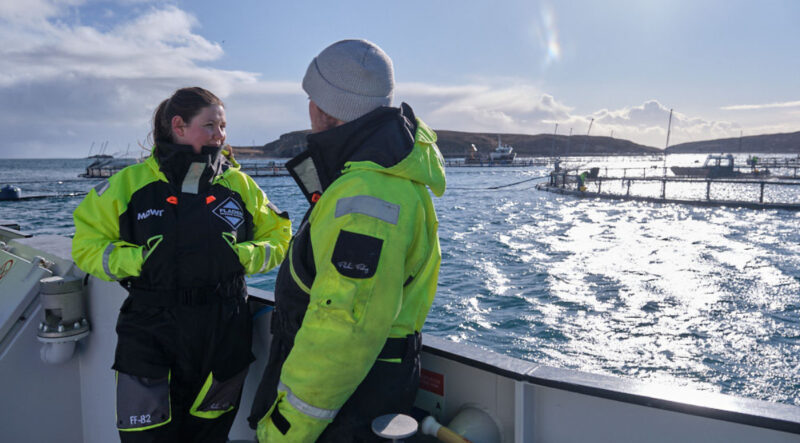Aquaculture is growing everywhere, except in Canada
Governments around the world are forging ahead with new plans, policies and laws to boost aquaculture.
By Fabian Dawson
SeaWestNews
From the United States and Scotland to Tasmania and across the Asia Pacific, governments around the world are forging ahead with new plans to boost aquaculture as they turn to the oceans to build food systems that are sustainable, affordable and resilient in the future.
Taking the cue from the Food and Agriculture Organization of the United Nations (FAO) which is calling on nations to strengthen aquaculture for food and sustainable development, many nations are facilitating progress for their seafood farming sectors while ensuring their oceans are protected.
“Given that aquaculture now supplies around 50 percent of aquatic food and given its potential to contribute to so many of the UN’s Sustainable Development Goals, we all need to focus on how to move it forward in a sustainable way,” said Xinhua Yuan, FAO’s Deputy Director for Aquaculture, at a recent conference.
Aquaculture is growing everywhere except in Canada, which has been hobbled by the fearmongering surrounding salmon farming and its impact on the environment.
While the opportunity to sustainably produce more salmon in Canada is unparalleled in the world the Liberal government has been unduly influenced by aquaculture detractors and activists rather than relying on science and traditional indigenous knowledge to grow the industry, states the Canadian Aquaculture Industry Alliance (CAIA).
On Canada’s west coast, about 40 per cent of the in-ocean salmon farming sector has already been closed, despite government scientists and court rulings stating that the salmon farms in British Columbia pose less than a minimal risk to wild stocks.
Here are some of the recent aquaculture-related developments around the world.
USA – Congressman Frank Pallone, Jr. (D-New Jersey) has announced the introduction of a bipartisan bill to support aquaculture and seafood industries. The Supporting Equity for Aquaculture and Seafood (SEAS) Act reforms federal agricultural policy to ensure these industries receive equal treatment within the United States Department of Agriculture (USDA).
“Investing in aquaculture will help ensure all Americans have access to safe and affordable seafood nationwide. When we increase the consumption of American seafood, we can alleviate food insecurity, create new economic opportunities, and reduce our food system’s impact on the environment,” Pallone said. “The SEAS Act will help us meet the growing demand for American seafood and provides critical Congressional support for USDA’s aquaculture programs. My bill makes critical investments in our aquaculture and seafood industries now, so that our food system is resilient in the future.”
Another aquaculture-focused bill being considered in Congress is the Advancing the Quality and Understanding of American Aquaculture (AQUAA) Act. This Bill aims to increase production of sustainable seafood through the raising of fish in federal waters, creating a robust industry in America including new jobs.
SCOTLAND – The Scottish Government has published its long-term vision for the aquaculture sector , recognising its “crucial role” in contributing to food security, net zero and high-skilled jobs. The Vision for sustainable aquaculture describes the Scottish Government’s aspirations to 2045 for the finfish, shellfish and seaweed farming sectors, and the wider aquaculture supply chain, said Mairi Gougeon, Scotland’s Cabinet Secretary for Rural Affairs.
“Aquaculture has a crucial role to play in contributing to our food security and meeting our commitment to becoming a Good Food Nation, producing healthy, nutritious food, with a greenhouse gas emissions profile that is lower than many other farmed sources of animal protein for people in Scotland and around the world,” she said. The aquaculture sector and its supply chain support 11,700 jobs in the Scottish economy. Tavish Scott, chief executive of Salmon Scotland, said:“We welcome this vision which puts salmon farming at the heart of the country’s economic growth plans, helping Scotland’s journey to net zero and supporting healthy diets.The blue economy has the potential to both increase food security at home and feed the growing global population.”
TASMANIA – A salmon industry that is economically successful, environmentally responsible, socially beneficial and well-managed is at the forefront of the recently published Tasmanian Salmon Industry Plan 2023. The plan’s vision will be delivered through four priority outcomes which have a focus on sustainable industry, healthy ecosystems, prosperous communities, and contemporary governance.
“Tasmania is surrounded by temperate oceans, with highly valued wild fisheries and exceptional opportunities for diverse forms of aquaculture. Over the past 40 years the Tasmanian salmon industry has emerged as a leader in innovation and producing premium seafood,” said Primary Industries Minister Jo Palmer when launching the plan.
Tasmania’s salmon industry had become the single biggest primary industry sector in the state, contributing $650 million annually to the local economy and employing about 2000 people directly.
ASIA PACIFIC – In 2021, Asia Pacific dominated the global aquaculture market, according to a report by The Insight Partners titled “Aquaculture Market Size Report, Forecast to 2028.
Countries like China, India, Japan, Australia, South Korea, Indonesia, and Vietnam, among others, have a plethora of aquaculture industries, which are being propelled by government policies. China now alone produces 60 per cent of the world’s farmed seafood, and Asia produces 90 per cent.
The Asia Pacific has evolved as the largest consumers and exporter of aquaculture products. Fisheries and aquaculture production are one of the major sectors contributing significantly to the economic growth of Asia Pacific countries. Seafood products are among the most traded commodities in the Asia Pacific region that bring valuable foreign exchange earnings in this region. Over the past few years, developing countries such as India and Thailand have become net exporters of fish, and a similar trend is projected to boost the aquaculture market in Asia Pacific over the coming years.
(Image courtesy of Mowi shows employees at a salmon farm in Scotland.)

